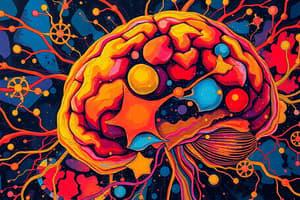Podcast
Questions and Answers
What are the two main divisions of the nervous system?
What are the two main divisions of the nervous system?
Which part of the nervous system is responsible for regulating involuntary functions like heart rate and digestion?
Which part of the nervous system is responsible for regulating involuntary functions like heart rate and digestion?
What is the main function of the brain within the nervous system?
What is the main function of the brain within the nervous system?
Which neurons are considered the functional units of the nervous system?
Which neurons are considered the functional units of the nervous system?
Signup and view all the answers
In what way does the central nervous system serve the body?
In what way does the central nervous system serve the body?
Signup and view all the answers
What type of information is processed by the somatic nervous system?
What type of information is processed by the somatic nervous system?
Signup and view all the answers
What is the function of dendrites in a neuron?
What is the function of dendrites in a neuron?
Signup and view all the answers
In the nervous system, what is the role of synapses?
In the nervous system, what is the role of synapses?
Signup and view all the answers
What is the primary function of the afferent pathway in the nervous system?
What is the primary function of the afferent pathway in the nervous system?
Signup and view all the answers
Which type of efferent pathway controls involuntary functions like heart rate?
Which type of efferent pathway controls involuntary functions like heart rate?
Signup and view all the answers
What is the main mechanism through which the nervous system integrates and coordinates responses?
What is the main mechanism through which the nervous system integrates and coordinates responses?
Signup and view all the answers
Which process allows the brain to adapt and change in response to experience?
Which process allows the brain to adapt and change in response to experience?
Signup and view all the answers
Study Notes
Exploring the Intricacies of the Nervous System
Our lives are a symphony of sensations, thoughts, and actions, all orchestrated by the intricate and vastly complex nervous system. This vital network, which can be traced back to the earliest evolutionary stages, is a marvel of human biology. Let's delve into the inner workings of this intriguing organ system, examining its structure, function, and the many roles it plays in our daily lives.
Divisions of the Nervous System
The nervous system is divided into two parts: the central nervous system (CNS) and the peripheral nervous system (PNS).
- Central Nervous System: Comprised of the brain and spinal cord, the CNS serves as the command center for our body. It processes information, interprets sensory input, and generates motor output in response. The brain, with its intricate cellular structures, is responsible for complex tasks like memory, emotions, and cognition.
- Peripheral Nervous System: The PNS is a network of nerves connecting the CNS to the rest of the body. It can be further divided into the somatic nervous system (responsible for voluntary motor control and sensory information) and the autonomic nervous system (regulating involuntary functions such as heart rate and digestion).
Structure and Function of Neurons
Neurons, or nerve cells, are the functional units of the nervous system. Each neuron contains a cell body, dendrites (which receive information from other neurons), and an axon (a long, slender projection that transmits signals to other neurons or muscles). Neurons communicate with each other through specialized junctions called synapses.
The nervous system uses electrical and chemical signals to communicate and process information. When a neuron is stimulated, an electrical signal, called an action potential, travels along the axon. At the terminus of the axon, the signal is converted into a chemical signal called a neurotransmitter, which diffuses across the synaptic cleft to bind to receptors on the receiving neuron's dendrites or cell body.
Signal Transmission in the Nervous System
The nervous system transmits signals through two main pathways:
- Afferent Pathway: This pathway carries sensory information to the CNS. Examples include touch, temperature, pressure, and pain.
- Efferent Pathway: This pathway carries signals from the CNS to muscles or glands. It can be further divided into two subtypes: somatic and autonomic. Somatic efferent pathways control voluntary motor movements, while autonomic efferent pathways control involuntary functions, such as heart rate and digestion.
Integration of the Nervous System
The nervous system is not only responsible for transmitting and processing information but also for integrating and coordinating the body's responses to stimuli. It achieves this integration through feedback loops, which are circuits that compare the current state of the body with a desired set-point and adjust the response as needed.
The Role of Neuroplasticity
Neuroplasticity, or the ability of the brain to change and adapt in response to experience, plays a crucial role in the nervous system. Through processes like synaptic strengthening, pruning, and neurogenesis, the nervous system can adapt to changes in our environment, learn new skills, and recover from injury.
The nervous system is a complex and fascinating organ system that is essential to our everyday lives. Understanding its structure, functions, and processes helps us appreciate the intricate workings of our bodies and the marvels of human biology.
Studying That Suits You
Use AI to generate personalized quizzes and flashcards to suit your learning preferences.
Description
Delve into the structure, function, and intricate processes of the nervous system. Learn about neurons, signal transmission, integration, and the fascinating concept of neuroplasticity. Explore how the nervous system coordinates our sensations, thoughts, and actions.





